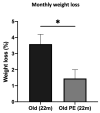Pomegranate Extract Administration Reverses Loss of Motor Coordination and Prevents Oxidative Stress in Cerebellum of Aging Mice
- PMID: 38001844
- PMCID: PMC10669012
- DOI: 10.3390/antiox12111991
Pomegranate Extract Administration Reverses Loss of Motor Coordination and Prevents Oxidative Stress in Cerebellum of Aging Mice
Abstract
The cerebellum is responsible for complex motor functions, like maintaining balance and stance, coordination of voluntary movements, motor learning, and cognitive tasks. During aging, most of these functions deteriorate, which results in falls and accidents. The aim of this work was to elucidate the effect of a standardized pomegranate extract during four months of supplementation in elderly mice to prevent frailty and improve the oxidative state. Male C57Bl/6J eighteen-month-old mice were evaluated for frailty using the "Valencia Score" at pre-supplementation and post-supplementation periods. We analyzed lipid peroxidation in the cerebellum and brain cortex and the glutathione redox status in peripheral blood. In addition, a set of aging-related genes in cerebellum and apoptosis biomarkers was measured via real-time polymerase chain reaction (RT-PCR). Our results showed that pomegranate extract supplementation improved the motor skills of C57Bl/6J aged mice in motor coordination, neuromuscular function, and monthly weight loss, but no changes in grip strength and endurance were found. Furthermore, pomegranate extract reversed the increase in malondialdehyde due to aging in the cerebellum and increased the reduced glutathione/oxidized glutathione (GSH/GSSG) ratio in the blood. Finally, aging and apoptosis biomarkers improved in aged mice supplemented with pomegranate extract in the cerebellum but not in the cerebral cortex.
Keywords: aging; cerebellum; frailty; motor coordination; oxidative stress; pomegranate extract.
Conflict of interest statement
The authors declare no conflict of interest. Pomanox® P30 product is from Euromed company, the Euromed company had no role in the design of the study; in the collection, analyses, or interpretation of data; in the writing of the manuscript, or in the decision to publish the results.
Figures









Similar articles
-
Pomegranate peel attenuates dextran sulfate sodium-induced lipid peroxidation in rat small intestine by enhancing the glutathione/glutathione disulfide redox potential.J Sci Food Agric. 2021 Aug 15;101(10):4278-4287. doi: 10.1002/jsfa.11067. Epub 2021 Jan 28. J Sci Food Agric. 2021. PMID: 33417238
-
Pomegranate (Punica granatum) peel extract provides protection against mercuric chloride-induced oxidative stress in Wistar strain rats.Pharm Biol. 2013 Apr;51(4):441-6. doi: 10.3109/13880209.2012.738333. Epub 2013 Jan 22. Pharm Biol. 2013. PMID: 23336580
-
Folic Acid Protects Rat Cerebellum Against Oxidative Damage Caused by Homocysteine: the Expression of Bcl-2, Bax, and Caspase-3 Apoptotic Genes.Neurotox Res. 2020 Mar;37(3):564-577. doi: 10.1007/s12640-019-00119-6. Epub 2019 Nov 13. Neurotox Res. 2020. PMID: 31721048
-
Cerebellar motor syndrome from children to the elderly.Handb Clin Neurol. 2018;154:151-166. doi: 10.1016/B978-0-444-63956-1.00009-6. Handb Clin Neurol. 2018. PMID: 29903437 Review.
-
Potent health effects of pomegranate.Adv Biomed Res. 2014 Mar 25;3:100. doi: 10.4103/2277-9175.129371. eCollection 2014. Adv Biomed Res. 2014. PMID: 24800189 Free PMC article. Review.
Cited by
-
Allium Macrostemon Bge. Attenuates the Cognitive Decline of Aging Mice by Enhancing BDNF/TrkB Pathway.Food Sci Nutr. 2025 Feb 28;13(3):e70010. doi: 10.1002/fsn3.70010. eCollection 2025 Mar. Food Sci Nutr. 2025. PMID: 40027296 Free PMC article.
-
Neonatal febrile seizures: Dimethyl itaconate's role in behavioral recovery and glutathione enzyme modulation in adult rats.PLoS One. 2025 Mar 25;20(3):e0318430. doi: 10.1371/journal.pone.0318430. eCollection 2025. PLoS One. 2025. PMID: 40131987 Free PMC article.
-
Pomegranate Extract Modulates Oxidative Stress by Reducing Basal ROS Levels and Protecting White Blood Cells from Induced Oxidative Damage in Aging Mice.Int J Mol Sci. 2025 Jun 20;26(13):5957. doi: 10.3390/ijms26135957. Int J Mol Sci. 2025. PMID: 40649737 Free PMC article.
-
Involvement of Aryl Hydrocarbon Receptor in Longevity and Healthspan: Insights from Humans, Mice, and C. elegans.Int J Mol Sci. 2024 Sep 14;25(18):9943. doi: 10.3390/ijms25189943. Int J Mol Sci. 2024. PMID: 39337431 Free PMC article.
References
Grants and funding
LinkOut - more resources
Full Text Sources

